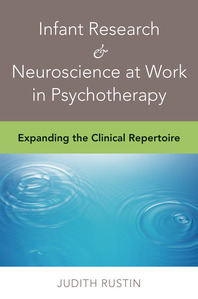
Infant Research & Neuroscience at Work in Psychotherapy
Expanding the Clinical Repertoire
15 January 2013
Territory Rights — Worldwide.
Description
Translating recent neuroscience and infant research to clinical practice.
By decoding the scientific data, this book explains how recent findings from brain and infant research can expand a clinician’s understanding of the therapist-client relationship and, in turn, improve how therapy is done. Offering clinical insights into key developmental mechanisms, Judith Rustin highlights the possibilities for new and creative treatment protocols. She summarizes and synthesizes basic concepts and ideas derived from infant research and neuroscience for clinicians not familiar with the literature. Using examples from her own practice to show how a clinician might integrate these concepts into psychodynamic practice, she invites other clinicians to experiment with finding their own pathways to integration of this valuable material in the clinical endeavor. Rustin explains how self- and mutual regulation (or bidirectional interaction)—concepts of which are both firmly grounded in the dyadic systems model of interaction—develop in infancy, how they contribute to a growing sense of self, and how they ultimately serve as templates for future interactions with others. She explains and shows how an understanding of them enriches a two-person perspective in clinical work. She then focuses on the brain science behind four additional concepts, each of which has particular application to clinical work: memory, the mind–body connection, the fear system, and mirror neurons and the concept of shared circuitry. Clinical material is interwoven with explications of each concept.
Reviews
"[F]or anyone interested in the burgeoning link between neuroscience and psychoanalytic concepts this book makes a very good and informative starting point." — The Psychologist
"Rustin organizes her chapters logically and writes in a very linear (easy-to-follow) manner, bringing the complexity of infant research and neuroscience into the reader’s reach. . . . Rustin develops a compelling argument that neuroscience can teach us much about the development of self and, more specific to psychotherapeutic relationships, the development of self with other. This concept is applicable to all who work in relationship with their clients. . . . We recommend this book to those seeking a better understanding of the brain basis for matters significant to therapeutic endeavors (e.g., affect regulation, trauma)." — PsycCritiques
"[A] rare treat . . ." — Somatic Psychotherapy Today
"Rustin summarizes key research in the areas of both infant behavior and neuroscience, and provides easy-to-understand examples that help clarify how rather elusive concepts—such as implicit and unconscious ways of remembering and communicating—can be applied in day-to-day therapeutic interactions. . . . Rustin has contributed an important addition to a growing body of work." — PsychCentral
"A beautifully written book . . . refreshingly clear. Rustin’s treatment of aspects of bodily experience, such as memory, fear, and mirror neurons, has much to teach us. The book is full of rich clinical examples in which she shares her own experiences as a therapist." — Beatrice Beebe, PhD, Clinical Professor of Psychology in Psychiatry, College of Physicians and Surgeons, Columbia University
"Written with the utmost respect for both subjective and scientific data, Rustin’s timely book recognizes the hybrid nature of psychotherapy. Her synthesis of essential findings from infant research and neuroscience with psychotherapy and psychoanalysis is clear enough to introduce the novice, yet clinically rich and sophisticated enough to inform the understanding and practice of highly knowledgeable clinicians." — Kenneth A. Frank, PhD, Director of Training, National Institute for the Psychotherapies, New York, NY
"Judith Rustin shares her journey to integrate concepts from infant research and neuroscience into her clinical practice. With detailed and specific examples and references to relevant research she shows how more explicit awareness of subtle implicit processes can lead to enhanced clinical interventions." — Christina Sekaer MD, PhD, Faculty, William Alanson White Institute



